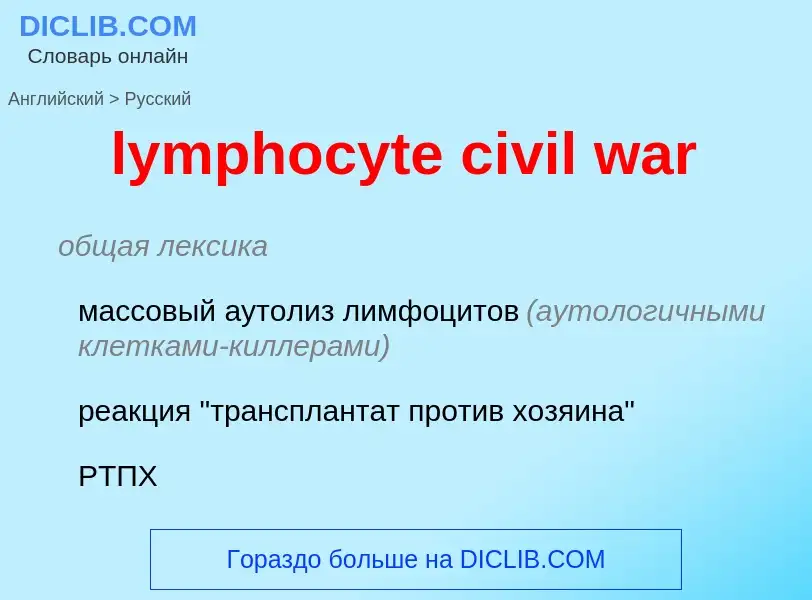Перевод и анализ слов искусственным интеллектом ChatGPT
На этой странице Вы можете получить подробный анализ слова или словосочетания, произведенный с помощью лучшей на сегодняшний день технологии искусственного интеллекта:
- как употребляется слово
- частота употребления
- используется оно чаще в устной или письменной речи
- варианты перевода слова
- примеры употребления (несколько фраз с переводом)
- этимология
lymphocyte civil war - перевод на Английский
общая лексика
массовый аутолиз лимфоцитов (аутологичными клетками-киллерами)
реакция "трансплантат против хозяина"
РТПХ
Смотрите также
медицина
лимфоидная клетка
Определение
Википедия

The Tajikistani Civil War (Tajik: Ҷанги шаҳрвандии Тоҷикистон, romanized: Jangi shahrvandiyi Tojikiston / Çangi shahrvandiji Toçikiston; Russian: Гражданская война в Таджикистане), also known as the Tajik Civil War, began in May 1992 when regional groups from the Garm and Gorno-Badakhshan regions of Tajikistan rose up against the newly formed government of President Rahmon Nabiyev, which was dominated by people from the Khujand and Kulob regions. The rebel groups were led by a combination of liberal democratic reformers and Islamists, who would later organize under the banner of the United Tajik Opposition. The government was supported by Russian military and border guards.
The main zone of conflict was in the country's south, although disturbances occurred nationwide. The civil war was at its peak during its first year and continued for five years, devastating the country. An estimated 20,000 to 150,000 people were killed in the conflict, and about 10 to 20 percent of the population of Tajikistan were internally displaced. On 27 June 1997, Tajikistan president Emomali Rahmon, United Tajik Opposition (UTO) leader Sayid Abdulloh Nuri and Special Representative of the United Nations Secretary-General Gerd Merrem signed the General Agreement on the Establishment of Peace and National Accord in Tajikistan and the Moscow Protocol in Moscow, Russia, ending the war.


![[[1990 Dushanbe riots]] [[1990 Dushanbe riots]]](https://commons.wikimedia.org/wiki/Special:FilePath/RIAN archive 699865 Dushanbe riots, February 1990.jpg?width=200)
![24 June 2007. Holiday flags on streets of [[Khujand]] in honour of 'Day of National Unity', declared a work-free holiday in 1998. 24 June 2007. Holiday flags on streets of [[Khujand]] in honour of 'Day of National Unity', declared a work-free holiday in 1998.](https://commons.wikimedia.org/wiki/Special:FilePath/TJ Primirenie.jpg?width=200)

![Destroyed turret of a [[T-62]] Destroyed turret of a [[T-62]]](https://commons.wikimedia.org/wiki/Special:FilePath/Destroyed turret of a T-62 in Tajikistan.jpg?width=200)
![Tajikistan factions in civil war: Leading clans: Northern [[Sughd Region]] (red), Southern [[Khatlon Region]] (blue), Eastern Islamic (green) Tajikistan factions in civil war: Leading clans: Northern [[Sughd Region]] (red), Southern [[Khatlon Region]] (blue), Eastern Islamic (green)](https://commons.wikimedia.org/wiki/Special:FilePath/Tajikistan fractions in civil war.gif?width=200)
![Kulob]] Kulob]]](https://commons.wikimedia.org/wiki/Special:FilePath/Ti-cities.gif?width=200)


![4D live imaging of T cell nuclear dynamics viewed using [[holotomography]] microscopy 4D live imaging of T cell nuclear dynamics viewed using [[holotomography]] microscopy](https://commons.wikimedia.org/wiki/Special:FilePath/T cell nuclear dynamics.gif?width=200)
![Several lymphocytes seen collected around a tuberculous [[granuloma]] Several lymphocytes seen collected around a tuberculous [[granuloma]]](https://commons.wikimedia.org/wiki/Special:FilePath/Tuberculous lymph node with caseating granuloma 40X.jpg?width=200)
.jpg?width=200)
![Aftermath of the [[Battle of Gettysburg]], [[American Civil War]], 1863 Aftermath of the [[Battle of Gettysburg]], [[American Civil War]], 1863](https://commons.wikimedia.org/wiki/Special:FilePath/Battle of Gettysburg.jpg?width=200)
![Communist]] soldiers during the [[Battle of Siping]], [[Chinese Civil War]], 1946 Communist]] soldiers during the [[Battle of Siping]], [[Chinese Civil War]], 1946](https://commons.wikimedia.org/wiki/Special:FilePath/Battle of Siping01.jpg?width=200)
![Fall and demolition of the [[Berlin Wall]] at [[Checkpoint Charlie]] (1990) Fall and demolition of the [[Berlin Wall]] at [[Checkpoint Charlie]] (1990)](https://commons.wikimedia.org/wiki/Special:FilePath/Berlin 1990 75540011.jpg?width=200)
![US Marines]], 1982. The [[Lebanese Civil War]] (1975–1990) was characterized by multiple foreign interventions. US Marines]], 1982. The [[Lebanese Civil War]] (1975–1990) was characterized by multiple foreign interventions.](https://commons.wikimedia.org/wiki/Special:FilePath/Checkpoint 4, Beirut 1982.jpg?width=200)
![Legionary Air Force]], allied to [[Francisco Franco]]'s Nationalists, bombs [[Madrid]] during the [[Spanish Civil War]] (1936–1939) Legionary Air Force]], allied to [[Francisco Franco]]'s Nationalists, bombs [[Madrid]] during the [[Spanish Civil War]] (1936–1939)](https://commons.wikimedia.org/wiki/Special:FilePath/Savoia-Marchetti SM.81.jpg?width=200)
![Members of ARDE Frente Sur during the [[Nicaraguan Revolution]] Members of ARDE Frente Sur during the [[Nicaraguan Revolution]]](https://commons.wikimedia.org/wiki/Special:FilePath/Smoke break el serrano 1987.jpg?width=200)
![The destruction wrought on [[Granollers]] after a raid by German aircraft on 31 May 1938 during the [[Spanish Civil War]]. The destruction wrought on [[Granollers]] after a raid by German aircraft on 31 May 1938 during the [[Spanish Civil War]].](https://commons.wikimedia.org/wiki/Special:FilePath/The destruction wrought on Granollers after raid.jpg?width=200)
![Whites]]" during the [[Finnish Civil War]], 1918 Whites]]" during the [[Finnish Civil War]], 1918](https://commons.wikimedia.org/wiki/Special:FilePath/Tykistokoulun harjoiitus.jpg?width=200)
